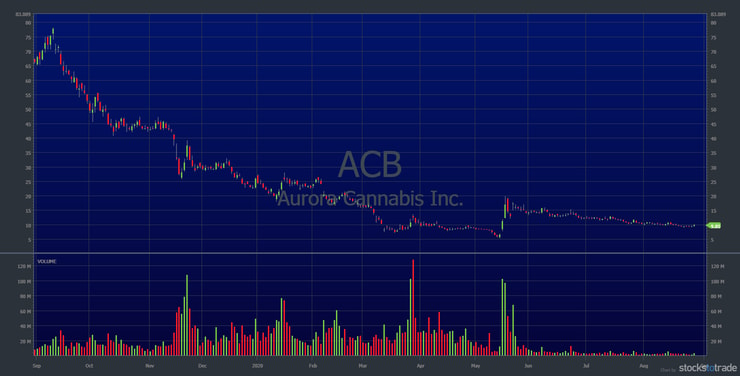What’s a stock reverse split?
The market’s buzzing about stock splits right now. Tesla Inc. and Apple Inc. recently announced stock splits, and their prices are rallying. But is a reverse split good or bad? What does it mean for the company, investors, and traders?

In this post, I’ll answer those questions. I’ll also explain why companies do reverse stock splits and whether you should trade them.
Keep reading…
Table of Contents
- 1 What Is a Stock Reverse Split?
- 2 How Does a Stock Reverse Split Work?
- 3 What Does a Reverse Stock Split Mean for an Investor?
- 4 Why Would a Company Do a Stock Reverse Split?
- 5 What Happens After a Reverse Stock Split?
- 6 What Are Reverse Split Advantages?
- 7 What Are the Disadvantages of a Reverse Split?
- 8 Do Reverse Splits Ever Work? See a Real-World Example
- 9 Should You Buy Stock Before a Reverse Split?
- 10 Should You Sell Before or After a Reverse Stock Split?
- 11 How Do You Calculate Stock Price After Reverse Split?
- 12 Which Stocks Will Do a Reverse Split in 2020?
- 13 Frequently Asked Questions About Stock Reverse Splits
- 14 Conclusion
What Is a Stock Reverse Split?
A stock reverse split means the company is reducing the number of shares outstanding. It’s the opposite of a stock split, where the company divides its shares into more shares.
With a reverse stock split, the company consolidates all its shares into a smaller supply, and the price of each share increases proportionally.
How Does a Stock Reverse Split Work?
Before a company can do a reverse stock split, it needs approval from its board of directors. After that, the company has to file with the U.S. Securities and Exchange Commission (SEC). (Learn how to read SEC filings here.)
They also have to tell the stock exchange, investors, and the public about the reverse stock split at least 10 days before it’s completed. They usually do that by issuing a press release.
A reverse split is announced as a ratio — for example, a 1-for-10 split, or 1:10. This means for every 10 shares you own, you receive one share after the reverse split. But your one share would be worth the same as 10 were previously.
The main purpose of a reverse split is to increase the share price.
What Does a Reverse Stock Split Mean for an Investor?

If you’re holding a position in a company when it does a stock reverse split, you’ll own fewer shares. But the price of each share is higher, so the overall value of your position remains the same.
Stock reverse splits are usually considered a bad thing. It’s a red flag if you’re invested in a company.
A reverse stock split means the share price has gone too low. It can be a sign that the company’s struggling financially and that nobody’s interested in it. And it could be at risk of being delisted from a major exchange.
A reverse stock split is a way a company can raise its stock price without adding any value.
Why Would a Company Do a Stock Reverse Split?
If a stock reverse split is usually considered a bad thing, then why would a company do it? Well, there are a couple of reasons …
They Want to Stay Listed on a Major Exchange
The major stock exchanges like Nasdaq and the New York Stock Exchange have minimum price requirements. To be listed on the Nasdaq, a company’s shares have to trade at more than $1 a share.
If a company’s stock trades below $1 for too long, they’ll get a letter giving them notice of the requirement to get the price back up within a certain amount of time. If they can’t, they risk being delisted and forced to trade on the OTC Markets.
They Want Access to More Investors
The OTC markets are known for penny stocks. These stocks aren’t as liquid as listed stocks, and they’re less visible to investors and traders than stocks listed on one of the major exchanges.
That’s because some hedge funds and portfolio managers aren’t allowed to trade stocks priced under a certain dollar amount or stocks listed on the OTCs.
Most legit companies don’t want to be known as penny stocks … Remember, Wall Street generally hates penny stocks.
So if a company wants a larger pool of investors and traders, it has to trade on a major exchange and keep its stock price up.
I can’t guarantee you success or profits, never forget 90% of traders lose, but I do guarantee you I’ll teach you every single thing I learned the hard way over 20+ years & that will only increase your odds as the proper rules, patterns & discipline are key to consistent profits!
— Timothy Sykes (@timothysykes) August 30, 2020
What Happens After a Reverse Stock Split?
So now you know what a reverse stock split is. But what happens after a reverse split? Well, that’s up to the company…
The company could use the reverse split as a catalyst to announce other restructuring plans or positive news at the same time. That could generate new interest from investors and traders.
Or it could just carry on with business as usual after the stock split. In that case, the stock price could fall right back to where it started.
A reverse split doesn’t change a company’s fundamentals or value. The company’s market cap remains the same.
But if the company can put a positive spin on things, it could create trading opportunities. Especially since the stock will have a lower float and increased volatility, which can be an advantage for traders like me…
Learn how to trade in this volatile hot market — get my NO-COST “Volatility Survival Guide.”
What Are Reverse Split Advantages?

The biggest advantage of a reverse stock split for the company is the higher stock price. It means the company gets to stay listed on the exchange.
When the stock reopens at a higher price, it will show up on stock scanners as a big percent gainer and grab traders’ attention.
If there’s enough demand, volume in the stock will increase and the price will go up. Especially if the company combines the split with a news catalyst.
Another advantage, for the company and traders, is the reduced supply.
If a stock has fewer shares outstanding, it’ll be more volatile. It doesn’t take as much relative volume to move the stock price. Companies want traders and investors interested in their stock, and volatility gets day traders’ attention.
If the company can increase demand by releasing a piece of good news or good earnings, the limited supply of shares will help the stock price climb faster.
Stocks with a low float are more volatile. I like trading volatile stocks. But you have to be on the right side of the trade and not overstay your welcome.
Volatility on the downside can be a disadvantage of a stock reverse split…
What Are the Disadvantages of a Reverse Split?
A volatile stock can rise quickly, but it can come down just as fast with a lot of selling pressure.
Sometimes a company will do a reverse split, release some good news to get the volume and interest in the stock up, and then do an offering to raise more money.
So it reduces the number of shares outstanding but then takes advantage of the new interest in the stock to sell more shares. Don’t trust these junk companies.
I don’t invest in penny stocks, I trade them. I believed in one of these companies once before and lost around $500,000.
Read about my mistake and giant loss for no cost in my book “An American Hedge Fund.”
Do Reverse Splits Ever Work? See a Real-World Example
Since the purpose of a stock split is to increase the share price, reverse splits can work in the short term. But it doesn’t mean the company can maintain that higher price.
The stock price can still drop back to where it started or fall even lower.
Let’s look at a recent example of a stock reverse split on Aurora Cannabis Inc. (NYSE: ACB).
ACB’s 1:12 reverse split was effective May 11. The stock opened down that day despite the reverse split. It was a bad sign to investors, and they jumped ship. The stock continued to fall for the next two days.
This is a good example of why you don’t just blindly buy a reverse stock split, which I’ll get into more later…
Three days after the reverse split, ACB announced some good news — its quarterly earnings rose — and the volume and price jumped. There was renewed interest in the stock.
The huge price gains continued for three days, with the stock rising from the $5 range to almost $20 per share…
But, as you can see from the chart, after the run-up, the stock resumed its downtrend.

Should You Buy Stock Before a Reverse Split?
In theory, a reverse split doesn’t change the value of your position. You won’t make money simply by holding overnight. And as we saw with the ACB example, the stock could still open lower.
I don’t like trying to predict what the market will do. Instead, I prefer to react to price action and news.
I trade my patterns and setups that have made me profitable over my 20+ years in the market. And I don’t see an edge in trading stock reverse splits. You have to trade what works for you.
Don’t blindly buy something based on a reverse stock split. Preparation is key. You need a strategy. You need a predictable pattern you can trade and adapt repeatedly over time.
My student Roland Wolf found an edge trading reverse stock splits. He shared his strategy in his presentation at the 2019 Trader & Investor Summit. His research, preparation, and studying paid off.
If you want to know more about Roland’s trading, check out this FREE webinar where he shares the strategy that helped him make consistent profits.*
*[Students’ results are NOT typical. Most traders lose. Always remember trading is risky, and never risk more than you can afford.]
Should You Sell Before or After a Reverse Stock Split?
To help you decide whether you should sell before or after a reverse split, let’s look at an example…
Say you bought a stock when it was running on good news. You bought 100 shares on the third day of a run-up to $10. The next day the stock tanked, but you believed it was just a correction and would come back up. It never did.
Now the shares are trading at $2 and the company announces a 1:5 reverse stock split.
This might sound like good news. You bought at $10 and now the stock will open at $10 after the split. Now you can finally break even … Wrong!
Before the split, you could sell your 100 shares at $2 each for a total of $200. After the split, you only have 20 shares that you can sell at $10, which equals … you guessed it … $200.
So it doesn’t matter if you sell before or after a reverse stock split. The value of your position stays the same. That’s why you should…
More Breaking News
- PDD Holdings: Is Now the Perfect Time to Hop on the Growth Wave?
- Is It Too Late To Buy Kenvue Stock? Here’s What the Latest Market Trends Suggest
- Can Verizon Overcome Challenges and Shine Bright Again?
Plan Ahead
Consider whether the stock price will go up or down after a reverse split.
New traders or investors might not know how a stock reverse split works … They could wake up and see that their stock is up that morning and immediately sell, thinking they’re banking.
If enough traders have the same thought, the stock price could go down from all the selling pressure. Also, if a reverse stock split is seen as a bad thing, investors could be dumping their shares.
On the other hand, when the stock shows up on stock scanners as a big percent gainer, it could get the attention of traders thinking there’s some kind of good news, and the stock price could go up with enough buyers.
With trading, there’s always a risk. That’s why I never recommend traders hold and hope. Rule #1 is to cut losses quickly so you don’t get yourself in these situations.
How Do You Calculate Stock Price After Reverse Split?
You can calculate what the stock price will be after a reverse stock split by using the company’s shares outstanding and market cap.
Let’s use the same example as above. A company is trading at $2 per share before a stock reverse split. They have 50 million shares outstanding. The market cap would be 100 million. They announce a reverse split of 1:5.
We have to divide the shares outstanding by the reverse split ratio to find out the new number of shares outstanding. Then divide the market cap by the new number of shares outstanding to find out the price per share.
A reverse stock split calculation would look like this:
50 million shares / 5 (the reverse split ratio) = 10 million shares outstanding
100 million market cap/ 10 million shares outstanding = $10 per share price
Which Stocks Will Do a Reverse Split in 2020?
Nobody in the stock market has a crystal ball. But the good news is, companies have to disclose their plans before doing a stock reverse split.
You can search online for a free reverse stock split calendar. It will list all the upcoming stock splits and reverse splits, along with the ratio and date the split will be completed.
Frequently Asked Questions About Stock Reverse Splits
New students always ask what might happen after a penny stock reverse split. Nobody can predict that, but below I answer some frequently asked questions about reverse stock splits to help you prepare.
Do You Lose Money on a Reverse Split?
If you’re holding shares through a reverse stock split, the value of your position stays the same as it was at the market close before the split. Once the stock reopens after the reverse split, if there’s selling pressure and the price goes down, you could lose money.
Can You Make Money on a Reverse Stock Split?
Stock reverse splits aren’t predictable. The stock could go up or down once it reopens. The increase in price is only due to the reduced number of shares. It doesn’t change the company’s fundamentals or make it more valuable.
After a reverse stock split, you’ll own fewer shares than you did before the split, but they’ll be worth more money. The total value of your position will remain the same.
I’ve been SO blessed to travel all over the world, see so many incredible things & meet so many amazing people, I wish you could all see what I’ve seen, but its not possible yet so for now study my videos, blog posts, DVDs, webinars, bootcamps & books, KNOWLEDGE IS LIFE-CHANGING!
— Timothy Sykes (@timothysykes) August 30, 2020
Conclusion
Reverse stock splits can be unpredictable. I don’t recommend holding a position through a reverse stock split.
A company does a stock reverse split because their share price has gone too low. It’s a sign that the company is in trouble and can’t get its stock price up based on real value.
The good things about a reverse stock split are the lower float and increased volatility. It can provide an opportunity for a trade if the company releases news.
I’m always looking at StocksToTrade scanners for big percent gainers. I helped design and am an investor in this trading and scanning platform to suit my penny stock strategies. Sign up for it, and add the Breaking News chat to be among the first to see breaking news.
To learn more about the setups and patterns I trade, apply for my Trading Challenge. I’ll teach you basic trading concepts and help you learn how to adapt to changing markets. You’ll get access to an ever-growing library of DVDs, webinars, my watchlists, trade commentary, and more.
But I only accept the most dedicated students. So be ready to study!
Have you been affected by a reverse split? Let me know in the comments … I love to hear from my readers!







Leave a reply